There are some monuments that have a very strong resemblance to other Civil War monuments
but are lacking an imprint,engraving,
plaque or other information that would confirm or deny their inclusion in this list.
|
LOCATION |
DESCRIPTION |
PHOTO
|
Bronson Cemetery,
Bourbon County |
A concrete monument with a central flagpole is in the center of the Bronson cemetery.
The style and location of this monument are consistent with other GAR related monuments.
There are no local inscriptions or other identifying information.
|
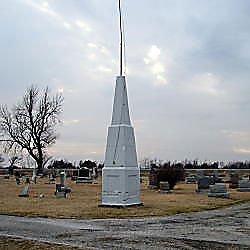
|
Fort Dodge Soldiers Home Cemetery,
Ford County |
Painted concrete monument similar to other Civil War markers.
The dark sections are recessed hollows that may originally have been carved scenes.
Only one still has part of an image. The remainder are too badly weathered to show any image.
|
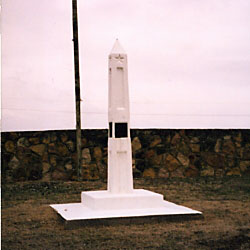
|
Walton Cemetery,
Harvey County |
This concrete monument appears similar to other G.A.R. monuments.
There are no inscriptions or other identifying information.
|
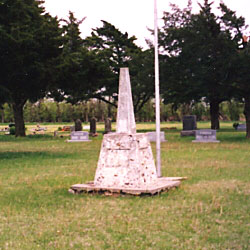
|
Waverly Cemetery,
Coffey County |
A concrete pad is on top of a small mound, centered in the old part of the cemetery.
It appears that a monument once stood on the pad.
The location and site are very similar to other local Civil War monuments.
|
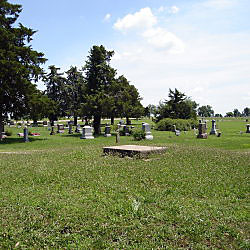
|
There are three counties in which no Civil War related memorials (primary or secondary) have been found.
Ironically, two of those counties are named after Civil War heroes (Logan and Scott counties).
|
LOCATION
|
DESCRIPTION
|
MAP DATA
|
Logan County
|
Logan County was organized September 17, 1887. It was named to honor the late General John A. Logan.
The county seat was changed from Russell Springs to Oakley in 1963.
Russell Springs was founded in 1865.
It was the Eaton stop on the Butterfield Overland Dispatch stage line connecting Fort Riley, Kansas,
to the Colorado gold mines.
Logan County has a population of 2,756 (2010 census).
|
 The following cemeteries have been investigated:
The following cemeteries have been investigated:
- Monument
-
- Oakley
-
- Page City
-
- Russell Springs
-
- Keystone Cemetery (SE of Russell Springs)
- Russell Springs Cemetery
- Winona
-
- Saint Joseph Cemetery
- Winona Cemetery
The old and new county seats (Russell Springs and Oakley) have also been explored.
|
Scott County
|
Scott County was created in 1873. It was named for General Winfield Scott (1786-1866).
It had no population for the first few years. By 1886 the county had enough residents to be officially organzed.
Scott County has a population of 2,234 (2010 census).
|
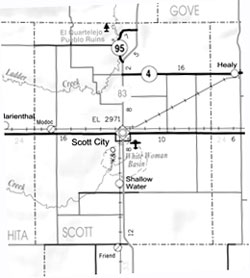 The following cemeteries have been investigated:
The following cemeteries have been investigated:
- Grigston Cemetery (south east of Grigston)
- Modoc Cemetery (east of Modoc)
- Pence Cemetery (south east of Pence)
- Scott County Mennonite Cemetery (north of Modoc)
- Scott City Cemetery (south west of Scott City)
The county seat (Scott City) has also been explored for monuments associated with the County Courthouse.
|
Wichita County
|
In 1885 the county had only seven houses. Wichita County was created in 1873.
By 1887 settlement was enough for county organization.
It was named after the Wichita Indians.
Wichita County has a population of 2,234 (2010 census).
|
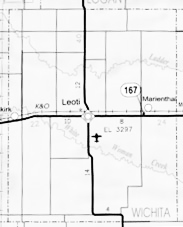 The following cemeteries have been investigated:
The following cemeteries have been investigated:
The county seat (Leoti) has also been explored for monuments associated with the County Courthouse.
|







